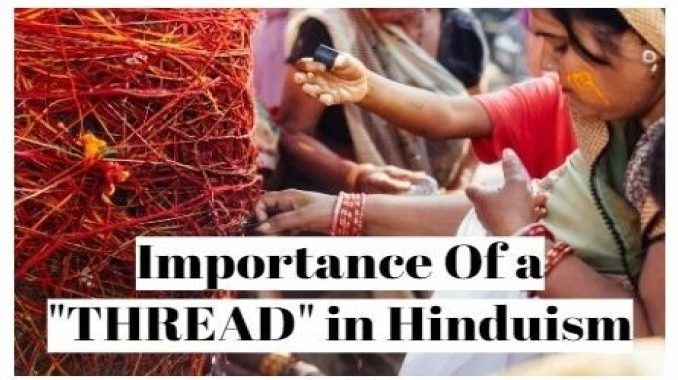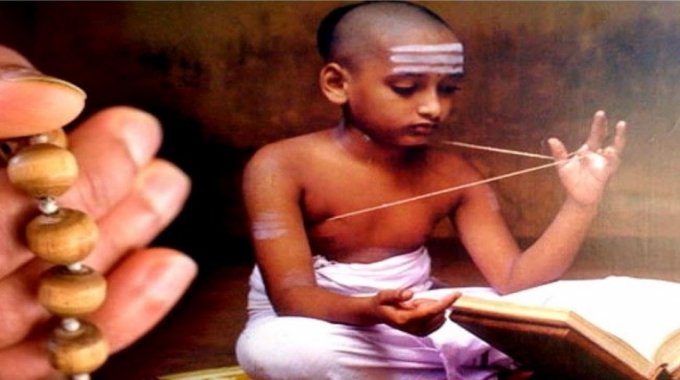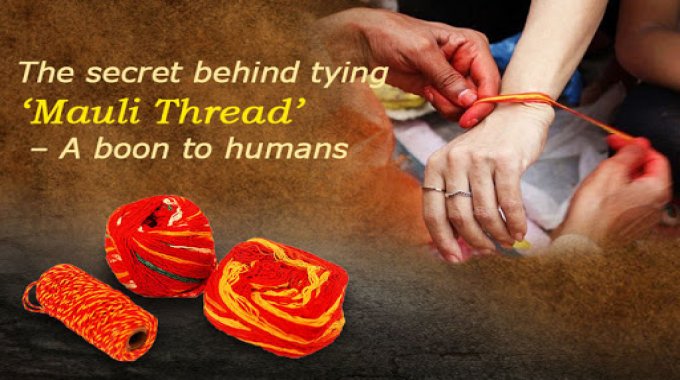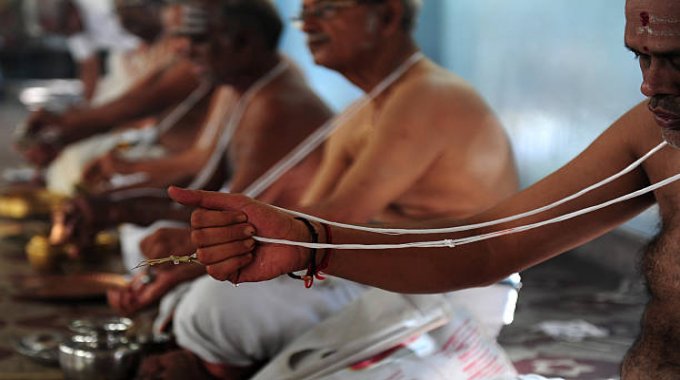 We have often seen Hindu people wearing kalava / molly (red / saffron/orange / yellow thread), black thread, janeu / yajnopaveet (white thread) around their wrists, chest, and ankles. Have you ever thought about why? What is the importance of just one thread? Well, we have answers to all the related questions, let us see:
We have often seen Hindu people wearing kalava / molly (red / saffron/orange / yellow thread), black thread, janeu / yajnopaveet (white thread) around their wrists, chest, and ankles. Have you ever thought about why? What is the importance of just one thread? Well, we have answers to all the related questions, let us see:
There are sixteen rites in Hinduism, Sanskar means making perfect, a sacred or sacred ceremony. These are sixteen rites, Garbadana (conception), Pusvan (fetal protection), Simanta (protection of pregnant mother), Jataka Karma (Shashthi) (natal rights for the development of the child’s intelligence, naming (naming of the child), Nishkarma (taking) ) Child out), Annaprashan (giving solid food to the child), Chaula or Mundan (hair cuttings), Karnaveedha (Kan Chidwana), Vidyadhar (introduction to the world of knowledge, music, dance and some forms of folk arts), Upanayana ( Vedam Rama (the study of the Vedas and scriptures), Keshanta (connected to understand the power of meaningful words), Samvedam (full education), Vivah (marriage) and funerals (funeral or funeral). The first three are prenatal ceremonies, the next There are six childhood rites, and the next five are concerned about education. Viva is marriage and funerals are a funeral ceremony.
Yagyopaveeta/Janeu (The Yellow Thread)
In fact, most Brahmins hold it on their chests. Also, people follow the tradition of applying it during the Upanayana rites. Upanayana means to lead the disciple to the Guru. There are three circles (threads) in the Ayugopaveet. Each thread has three knots that tie a knot. The word “Yajnopaveet” is an amalgamation of “Yajna” as well as “Up” and “Pavel”. Not the best, but the best action is “yajna”, ‘up’ means ‘near’, ‘vet’ means, spread, desired, nurtured.
Thus, people wear Yajnopaveet with the desire to perform their best. It is the initiation of attaining spiritual knowledge. On this occasion, patrons teach the Savitri / Gayatri Mantra to the beginner. This mantra is one of the most sacred mantras. It is a mantra that attains enlightenment / ultimate Brahm / knowledge and plays an important role in attaining the highest desire of life i.e. liberation. Gayatri Mantra is chanted by wearing this Yagyopaveet. The meaning of Gayatri Mantra is given below:
Meaning
Almighty Supreme Father, the Creator of the entire universe, is the essence of our life existence, which removes all our sorrows and suffers sorrows. Inspire your divine grace to assimilate within us. His divinity and talent that can purify us and take our religious knowledge on the right path.
Yajnopaveet is a sacred thread. It has three varieties, including a seated cow. The three varieties represent the three Vedas and the knot represents the Atharvaveda. Furthermore, it represents the first three stages of life i.e. Brahmacharya, Grihastha, and Vanaprastha as well as the three Agni, called Gadhapatya, Dakshinagni, and Ahavaniya. People start it with the left shoulder, which passes over the heart and goes backward in a knot at the right end.
The left shoulder is the basis for carrying the weight of life with tolerance. The heart is a point of determination and belief. The back symbolizes commitment; Thus Yajnopaveet represents the Sadhana (Siddhi) of the purest with a sense of cleanness, courage, faith, commitment, and shamelessness.

Also Read: Guru of this Bollywood superstar taught dance after watching horoscope, know why
In-depth explanation
After initiation, the early people expected to spend the whole of their lives with Vandana and Agnayya. Sandhya Vandana means worshiping the sun god in the morning and afternoon. Traditionally, people perform by the Dwij communities of Hindus. And it means “Greetings at dusk or solar noon”.
Apart from this, it includes offering to Agni Dev, praying for the longevity of life, fast, intellectual ability, general ability, name, fame, etc. Sandhyadhana involves many steps like Achman, Pranayama, Marjan, Arghyapradhan, Gayatrijapa, Suryopasthana. Where Ashman is shedding water three times a day and purifying other parts of the body, Pranayama is divided into “Prana” which means breathing and “Yama” means regulating exercise controls.
Pranayama consists of five systems – prana (respiratory system), Apana (excretory system), vyana (circulatory system), Samana (digestive), and Udana (reversal system). Ideally, Yajnopaveet is one of the most important ceremonies in a person’s life. It is baptized in Hinduism! Jane is not a simple thread, its purity is disturbed if it is not worn properly.
KALAWA / MAULI (Red / Yellow / Orange / Saffron thread)
According to Hindu mythology, in the Vamana avatar, Lord Vishnu pushed King Bali into Sheol. It is believed that he tied a red thread (Kaleva / moli) on Bali’s wrist to grant him immortality. That the practice of tying red thread on the wrist of people started, so that they can get a long life. When Kalava is tied on your wrist, it should always be done with your palm, always three knots tied. Inside your wrist, there are three nerves or nadis (popularly known) on the side of your palm.

Also Read: Palmistry Secrets to a Happy Married Life!
Split Meanings
Each of these nadis is associated with three-body two-core components: Vata, Pitta, and Kapha, where Vata or Vayu is the impulse principle required to speed up the functioning of the nervous system.
Pit or bile, which is useful indigestion, supplies blood and energy to various parts of the body. Kapa or Kapha, the carrier of nutrients in the arterial system. So, by tying the three knots, Kalava creates enough pressure on these nerves, each to keep your body free from any disease related to these three components.
Moli or Kalava is an identity of Hinduism. It is a red, yellow, orange colored thread, usually tied in the hands of both men and women. The tying of Kaleva is an important tradition indicating that a person is performing rituals (puja ko mangalik (good) kriya (kama)). The literal meaning of Mauli in Sanskrit is ‘Mukut’, which means top.
Therefore, Lord Shiva is known as Lord Chandramouli because he adorns the crescent on his matted hair. It is a cotton string, mostly red in color with small pieces of yellow, which have some miraculous power to protect you from bad energy. This sacred thread is tied by spinning seven times before or after the sacred worship (prayer) ceremony.
The sacred thread is tied by the guru or elderly members, especially the grandparents of the family on each person’s wrist, who are present in the holy ceremony, reciting the Sanskrit mantra (mantra for success) while tying the guru. And worn to overcome them. The person wearing this red thread removes negative energy. The mantra with meaning is:
येन बद्धो बलीराजा दानवेन्द्रो महाबल:।
तेन त्वामनुबध्नामि रक्षे माचल माचल।।

Also Read: The worst phase of Shani Sade Sati?
Meaning
“The king who obliged Bali, who was great in charity and very strong. With this, I’m tying you still be still
It is believed that reciting sacred mantras affects the thread positively and invokes the Satvik (pure) status in humans. Also, it protects the user from all negativity and bad effects; It also keeps away from dangers, diseases, and enemies.
Furthermore, it is believed that by tying Mauli, Trideva-Brahma, Vishnu and Mahesh, and Tridevi- Lakshmi, Saraswati, and Durga are blessed; Is given to the devotee. From Brahma, we get fame, with the blessings of Lord Vishnu give us the power to protect us from evil, and with the blessings of the Supreme Shiva we get the power to end all of us.
Mythological depth
On the other hand, we get enlightenment from Goddess Saraswati, we get prosperity with the blessings of Goddess Lakshmi and we get stronger through the blessings of Goddess Durga.
In the Mahabharata, during a battle, Kunti tied a red thread (molly) on the wrist of Abhimanyu’s right hand as a protective shield. No warrior could defeat Abhimanyu. However, it is only when a mouse is closed by a thread that his protection is lost and he dies.
Also Read: Mars Planet – Importance of Mars in a Horoscope & Mars effects in Astrology
There is also a science behind tying Molly to the wrist. According to Human Anatomy, our wrists have nerves. Nearly all prime veins pass through here. Tying molly thread improves blood circulation, which balances the trinity, Vata, bile, and phlegm. As a result, there is no disturbance in the body system.
Molly wearer is protected from fatal diseases like paralysis, diabetes, heart disease, etc. According to acupressure, when you wear molly on the wrist, there is no tenderness in the blood, which keeps your immunity strong and fit.
Black thread
According to Indian mythology, black thread absorbs all evil things. People often apply it to the waist. Also, it helps in keeping weight and waist size under control by improving digestion. When we wear a thread at the waist and if that thread becomes loose ie we have lost weight and if it is tight then it means we have gained weight. The black thread at the waist helps in proper elimination.
It improves the strength of the intestines, improves digestion, and makes bowel movement proper and easy. It also improves kidney and bladder functions. When added, it improves spinal health by providing support in the area of the lumbar spine. The black thread at the waist keeps away problems such as lower back pain, spine problems; Slip discs, etc., retaining spinal fluid.
